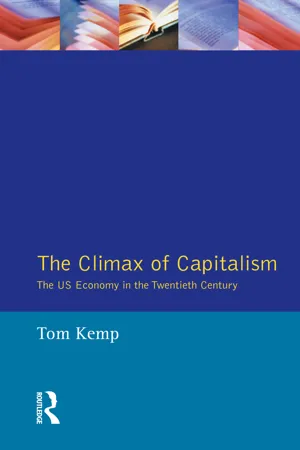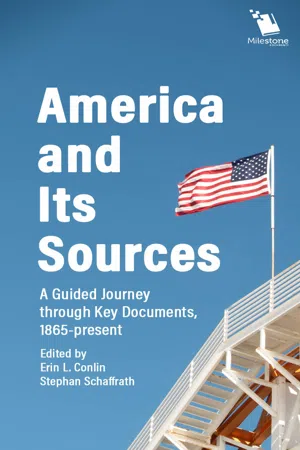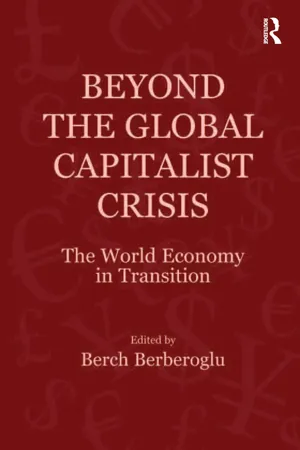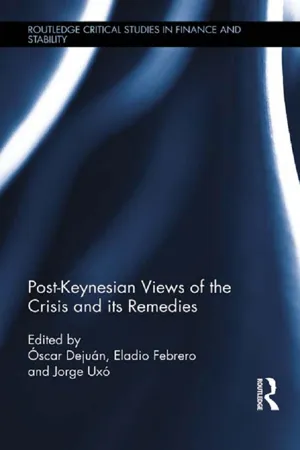Economics
Great Depression
The Great Depression was a severe worldwide economic downturn that began in the late 1920s and lasted through the 1930s. It was marked by a significant decline in industrial production, widespread unemployment, and deflation. The stock market crash of 1929 is often cited as the starting point of the Great Depression, which had far-reaching social and economic consequences.
Written by Perlego with AI-assistance
Related key terms
8 Key excerpts on "Great Depression"
- eBook - ePub
Rethinking Macroeconomics
A History of Economic Thought Perspective
- John F. McDonald(Author)
- 2021(Publication Date)
- Routledge(Publisher)
8 The Great DepressionIntroduction
The Great Depression of the 1930s was both the deepest and longest depression in U.S. and European history. This chapter provides a brief review of the facts and theories that have been advanced as explanations for this economic disaster. The focus of the chapter is on the U.S. and U.K. economies, but briefer discussions of other European economies are included. Some of the same themes are pertinent to the first decade of the 21st century. A great number of economists and historians have weighed in on the Great Depression, of course, and there is no consensus on a single main cause of the depression. However, there does appear to be agreement that there were several causes and exacerbating factors.The English classical economist A. C. Pigou published a book titled Industrial Fluctuations in – of all years – 1927, in which he examined six possible fundamental reasons for economic fluctuations. These are errors of optimism and pessimism, agricultural fluctuations caused by weather, new inventions, monetary instability, changes in tastes, and industrial strikes. But Pigou argued that, in all cases, the economy would return to full employment quickly. As noted in Chapter 2 , Pigou served as the main example of outmoded thinking for Keynes.As you know already, most macro economists divide into three main schools of thought – Keynesian, Monetarist, and real business cycle. (The Austrians are a small group among professional economists.) According to Keynes (1936), a depression is the result of aggregate demand that is deficient to employ the resources of a nation. Demand consists of four categories: private consumption, private investment, government purchases of goods and services, and net foreign trade in goods and services. These four add up to the gross domestic product (GDP), the total measure of the value of all final goods and services produced during a year. In a nutshell, Keynes thought that private investment was the volatile component of aggregate demand because it depended on expectations of future profits, and those expectations can change abruptly according to “animal spirits,” the willingness (or unwillingness) to take risks. If firms look ahead and conclude that future profits are not there, then investment spending on plants and equipment will drop quickly. Likewise, builders of housing (also a component of investment) decide to cut back based on their expectations. Employment falls, so household income falls, which in turn causes declines in consumption spending and further declines in employment and income. This process is the Keynesian multiplier. - eBook - ePub
The Long Depression
Marxism and the Global Crisis of Capitalism
- Michael Roberts(Author)
- 2016(Publication Date)
- Haymarket Books(Publisher)
Chapter 3 The Great Depression of the Mid-Twentieth CenturyThe Great Depression was (and in many ways remains) a great puzzle as there were millions of the world’s citizens who wanted to consume more housing, food and clothing; and producers by the hundreds of thousands who wanted to manufacture more housing, food and clothing and yet the two sides could not get together. Why? What was preventing these economically improving, mutually beneficial changes taking place? What was it that prevented people from working and producing more? At this moment, the answer remains largely unknown.—Randall E. Parker 1To understand the Great Depression is the Holy Grail of macroeconomics.—Ben Bernanke 2The Trigger for the DepressionThe long depression of 1873–97 was originally called the Great Depression. It was seen as a one-off event by even the most perceptive of analysts, 3although there were hints in the analyses of the Dutch long-wave theorists and the Russian economist Kondratiev that such a depression could reoccur. What we know today as the Great Depression, which started in 1929 and carried on until the beginning of World War II, showed that the long depression of the late nineteenth century was not a unique event in capitalist development and could be repeated. However, mainstream economics has been unable to explain what happened to world economies in the 1930s or why.4At around the beginning of 1928, the US Federal Reserve, worried about financial speculation and inflated stock prices, began raising interest rates. Industrial production turned downward in spring 1929, and overall growth turned negative in the summer. A recession had begun. In the two months leading up to the Wall Street crash, industrial production fell at an annualized rate of 20 percent. When the financial crash came, it was savage, and stunning drops in the stock market followed. By mid-November the market had declined by half. - eBook - ePub
The Climax of Capitalism
The U.S. Economy in the Twentieth Century
- Tom Kemp(Author)
- 2014(Publication Date)
- Routledge(Publisher)
A decade of crisis: 1929—1939By its unexpectedness, its scale and its duration, the Great Depression of the 1930s had a traumatic effect on all sections of American society. Coming as a sequel to several years of prosperity which had led business spokesmen and leading economists to forecast a new era of crisis-proof expansion, it proved to be the longest and deepest in history.For three and a half years following the Wall Street crash, the economy continued on a downward plunge, ruining millions of small businessmen and farmers, condemning one quarter of the labour force to unemployment and almost destroying the banking system. In what Americans proudly assumed was the richest country in the world, the living standards of many unemployed workers and poor soil farmers fell to 'third world' levels. The blow to the 'American dream' was so sudden and severe that the reaction of many was one of disbelief and passivity rather than of anger. There was no sharp turn to the left by a segmented working class, no mass middle-class support for a far-right saviour - though both tendencies were later to appear.The explanation of the Great Depression poses many problems for economists and it is not surprising that no consensus should exist. Many were, and still are, reluctant to attribute it to some organic weakness of capitalism, looking rather to extraneous circumstances, mistakes in government policy or wrong decisions by the monetary authorities.The Greatest Depression
Most accounts of the Depression begin with the Wall Street crash, so that the beginning of the Depression can be exactly dated to 24 October 1929. It is unlikely that the crash would have been followed by such devastating consequences had there not been about this time the coming together of various factors making for a slump. The crash, while particularly severe, was a financial panic of a classic type familiar in the financial history of European countries as well as the United States. Its form was a rush into liquidity by those holding shares, and later, other types of paper - bonds, securities, bills of exchange bringing prices crashing down. In the previous months share prices had been rising at an extraordinary rate, the result of excessive speculation in which large numbers of people, including many newcomers to stock-market transactions, had been participating. In such speculative manias, a time comes when confidence in the continued upward movement of stock-market prices begins to break. Some feel the urge to sell before the fall begins, or become overcommitted and have to sell to settle payments elsewhere. Once selling generates a fall there is a good chance that the movement will spread until it becomes an avalanche. Weaknesses and frauds are exposed, and it becomes virtually impossible to reverse the trend. - eBook - ePub
America and Its Sources
A Guided Journey through Key Documents, 1865-present
- Erin L. Conlin, Stephan Schaffrath(Authors)
- 2019(Publication Date)
- Schlager Group Inc.(Publisher)
Throughout history, the American economy has had periods of growth followed by periods of recession and depression. That is part of a normal economic cycle. What made the depression of the 1930s so “great,” however, was the scope and scale of the disaster. Roughly a quarter of the nation was unemployed during the 1930s. (In a healthy economy, unemployment rates are typically about 4 to 5 percent.) Millions of Americans became migrants—people with no permanent home—because they had lost their land or jobs working in agriculture. No one knew how to end the Depression, because to date, the nation had never suffered such a severe one. Franklin Delano Roosevelt, elected president in 1932, promised to lead the country in a new direction.Note: When you’re referring explicitly to the Great Depression, “Depression” is capitalized. When speaking generally about an economic depression, it is lowercase.Unit Questions 1. Why is the Great Depression seen as a watershed moment in American history? To answer this question, think about the many ways that it affected all sorts of people across the country.2. How did different groups of people experience the Depression differently? Create a matrix or diagram with a list of different types of people (on the left) and the ways in which these people experienced the Depression (on the right).3. How and why did the role of the U.S. government change in society from the 1920s through the 1930s? Here it would be helpful to make two lists of government policies: one for policies that contributed to the Depression and another one for policies that were designed to lift the country out of the Depression.Passage contains an image
6.2 Herbert Hoover: “Rugged Individualism” Campaign Speech (1928)Historical ContextFollowing World War I, the United States pulled back from international affairs and focused on domestic growth. The Republican Party led efforts to roll back Progressive-era legislation to stimulate business growth. Although Republicans did not call it laissez faire, - eBook - ePub
Beyond the Global Capitalist Crisis
The World Economy in Transition
- Berch Berberoglu(Author)
- 2016(Publication Date)
- Routledge(Publisher)
1 Howard J. ShermanEvery expansion in U.S. history has been followed by an economic contraction. If the contraction is relatively mild by historical standards, it is called a recession. If it is more severe, it is called a depression. When the contraction lasted ten years and official unemployment went up to 25 percent in the 1930s, it was called the Great Depression.“Absolutely sound” was President Calvin Coolidge’s assessment of the economy and the stock market merely a few months before Hoover swore in as President in January 1929. In the fall of 1929, Hoover’s secretary of the Treasury, Andrew Mellon, reassured one and all that “there is no cause to worry. The high tide of prosperity will continue.” Finally, in mid-October 1929, no less than Irving Fishing, the preeminent U.S. economist of his day, proclaimed that “stock prices have reached what looks like a permanently high plateau” (see Galbraith 1988: 15, 26, 41, and 70).A few days later the stock market crashed, and the U.S economy sank into a depression that was to last a decade. By 1933, at least 25 percent of the labor force was unemployed and another 25 percent were on involuntary part-time work or were so discouraged that they gave up looking for jobs. The homeless, the hungry, and the desperate were never fully counted. The most famous pictures of the era showed long lines of people waiting for free bread or a bowl of soup. These breadlines, as they were called, would sometimes extend for blocks from the entrance of a soup kitchen.The term “depression” was commonly used before World War II to refer to any economic contraction. From 1948 to 2001, there were 10 minor contractions. Conservatives did not like the term “depression” because it reminded everyone of the horrors of the Great Depression which they would rather forget, while denying that the economy had any basic problem. So the conservatives invented the term “recession” to convey the idea that the problem was mild and temporary. Eventually the term “recession” was widely used. - eBook - ePub
Property and Prophets: The Evolution of Economic Institutions and Ideologies
The Evolution of Economic Institutions and Ideologies
- E. K. Hunt(Author)
- 2016(Publication Date)
- Routledge(Publisher)
CHAPTER 12 Keynesian Economics and the Great DepressionAlthough the period from the Civil War to 1900 was one of rapid economic expansion in the United States, these accomplishments were dwarfed by the growth that occurred between 1900 and 1929. Table 12.1 presents the percentage increase in manufacturing production in several key industries between 1899 and 1927. It has been estimated that U.S. wealth (the market values of all economic assets) reached $86 billion by 1900; in 1929, it stood at $361 billion (data in Huberman 1964, p. 254).This spectacular growth gave the United States a huge edge over all other countries in manufacturing output. The American prosperity of the 1920s was based on high and rising levels of output, though there were recessions in 1923 and 1927. The gross national product, the value of all goods and services produced, increased by 62 percent from 1914 to 1929. Only 3.2 percent of the labor force was unemployed in 1929, and labor productivity rose during that decade at least as fast as wages. Between 1921 and 1929, total automobile registrations increased from less than 11 million to more than 26 million; consumers spent tens of millions of dollars on radios, refrigerators, and other electric appliances that had not been available before. American manufacturing seemed to most people a permanent cornucopia destined to create affluence for all.This leadership in manufacturing was associated with financial leadership in the world economy. The American economic empire began to rival that of England. By 1930, American businessmen owned large investments around the world. Table 12.2 gives the value of these investments in 1930 in millions of dollars.The Great DepressionThis era of rapid growth and economic abundance came to a halt on October 24, 1929. On that “Black Thursday,” the New York stock market saw security values begin a downward fall that was to destroy all faith in business. Their confidence undermined, businessmen cut back production and investment. This decreased national income and employment, which, in turn, worsened business confidence even more. Before the process came to an end, thousands of corporations had gone bankrupt, millions were unemployed, and one of the worst national catastrophes in history was under way. - Óscar Dejuán, Eladio Febrero Paños, Jorge Uxo Gonzalez(Authors)
- 2013(Publication Date)
- Routledge(Publisher)
Introduction Óscar Dejuán, Eladio Febrero and Jorge Uxó Another book on the crisis? Value added of this book The Great Depression of 1929 not only shook the foundations of the economy but also those of economics as a science. At that time Keynes was finishing the Treatise of Money, a work that proposed some changes in the traditional interpretation of the business cycle. While the book was in press, he realized that instead of amending the paradigm he had better shift to a different one. In a letter to George Bernard Shaw, dated 1935, Keynes wrote: you have to know that I believe myself to be writing a book on economic theory which will largely revolutionize — not, I suppose, at once but in the course of the next ten years — the way the world thinks about economic problems. A new economic paradigm certainly emerged from the dashes of the Great Depression. Yet, Keynes's novel ideas were soon absorbed by mainstream economics. Only a few of Keynes's and Kalecki's disciples tried to deploy its revolutionary content. We are thinking of people like Roy Harrod, Richard Kahn, Joan Robinson or Nicholas Kaldor. This is the origin of the post-Keynesian school. A group that, despite its small size, has generally had a say in the major economic debates of the second half of the twentieth century. This is an advantage of being near the loudspeaker of economics. The Great Recession of 2008 is comparable in depth and length to that of 1929. Can it be interpreted and solved by the neoclassical paradigm that continues to be the dominant one? Are the old Keynesian ideas a better alternative or should they be redefined to adapt to new circumstances? Would new economic ideas and new institutions emerge from the current crisis to define a brand new paradigm? In a previous book (Dejuán et al, 2011) we asked economists from different streams of thought to reflect on the causes of the first Great Recession of the twenty-first century. “Competing views on the crisis” was its subtitle- eBook - ePub
A History of American Economic Thought
Mainstream and Crosscurrents
- Samuel Barbour, James Cicarelli, J. E. King(Authors)
- 2017(Publication Date)
- Routledge(Publisher)
7 Economic thought from the Great Depression through the golden age of economic growth, 1929–1973Introduction
This chapter begins in the year of the Wall Street crash and ends in the year in which the Bretton Woods system broke down. In between there was a decade of deep depression and faltering recovery (1929–1941), four years of world war (1941–1945) and almost three decades of sustained prosperity, the so-called ‘golden age’ of post-war American – and indeed global – capitalism (1945–1973). There were equally dramatic changes in the nature of American economics, which was completely transformed. By 1973 formal modeling and rigorous econometric techniques were the norm, rather than the preserve of a small minority as had been the case in 1929. The earlier pluralism of ideas and methods had given way to an increasingly monolithic neoclassical mainstream, which was exerting great influence over the ways in which economics was taught and practised all over the world. This is covered below. For most of the period the ‘Other Voices’ and ‘Crosscurrents’ were operating in an increasingly difficult intellectual and institutional environment. At the very end of the period, however, there were some indications that dissident ideas were beginning to revive.Economic, social, political conditions
In 1930 the population of the United States was 122.8 million, 11.6 percent of whom had been born overseas. By 1970 total US population had risen to 203.3 million, but the virtual cessation of mass immigration for two decades after 1929 meant that only 4.8 percent were now foreign-born, the lowest proportion ever recorded (Hughes and Cain 2011, 558). It was an increasingly urbanized population, with the proportion employed in primary production (agriculture, forestry, and fishing) falling from 17.4 percent in 1940 to a mere 3.1 percent in 1970. Those working in the secondary sector (manufacturing, construction, and transport) rose from 39.0 percent in 1940 to an all-time high of 41.0 percent in 1950, before beginning a slow but steady and continuing relative decline to 35.8 percent in 1970. Employment in the tertiary sector rose steadily, from 43.5 percent of total employment in 1940 to 61.1 percent in 1970, by which time the United States was well on the way to becoming a service economy (Hughes and Cain 2011, 567).
Learn about this page
Index pages curate the most relevant extracts from our library of academic textbooks. They’ve been created using an in-house natural language model (NLM), each adding context and meaning to key research topics.







